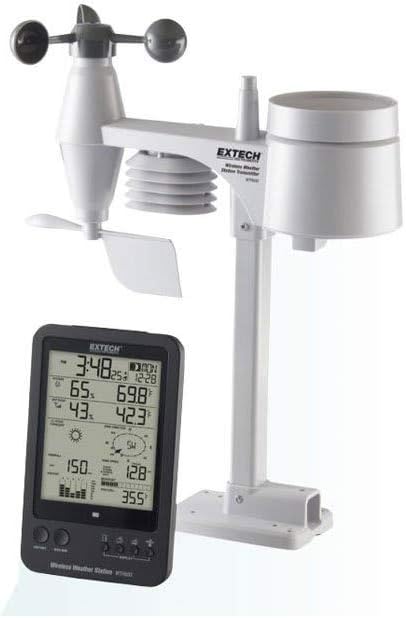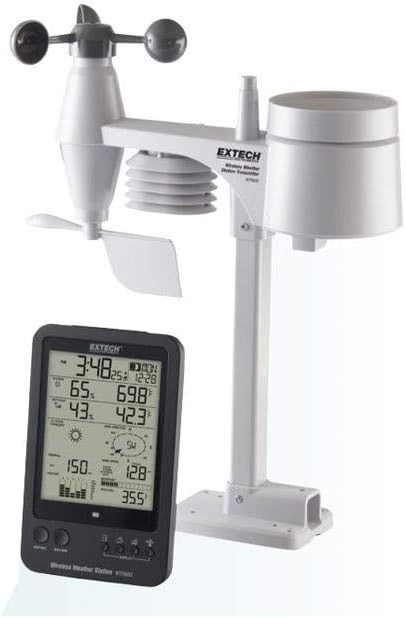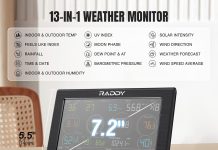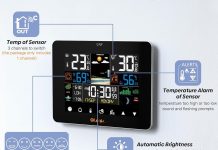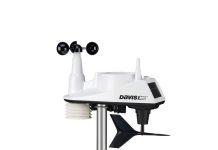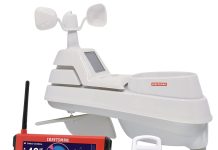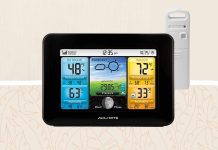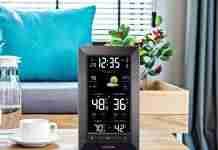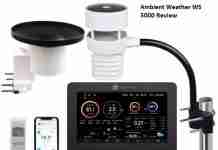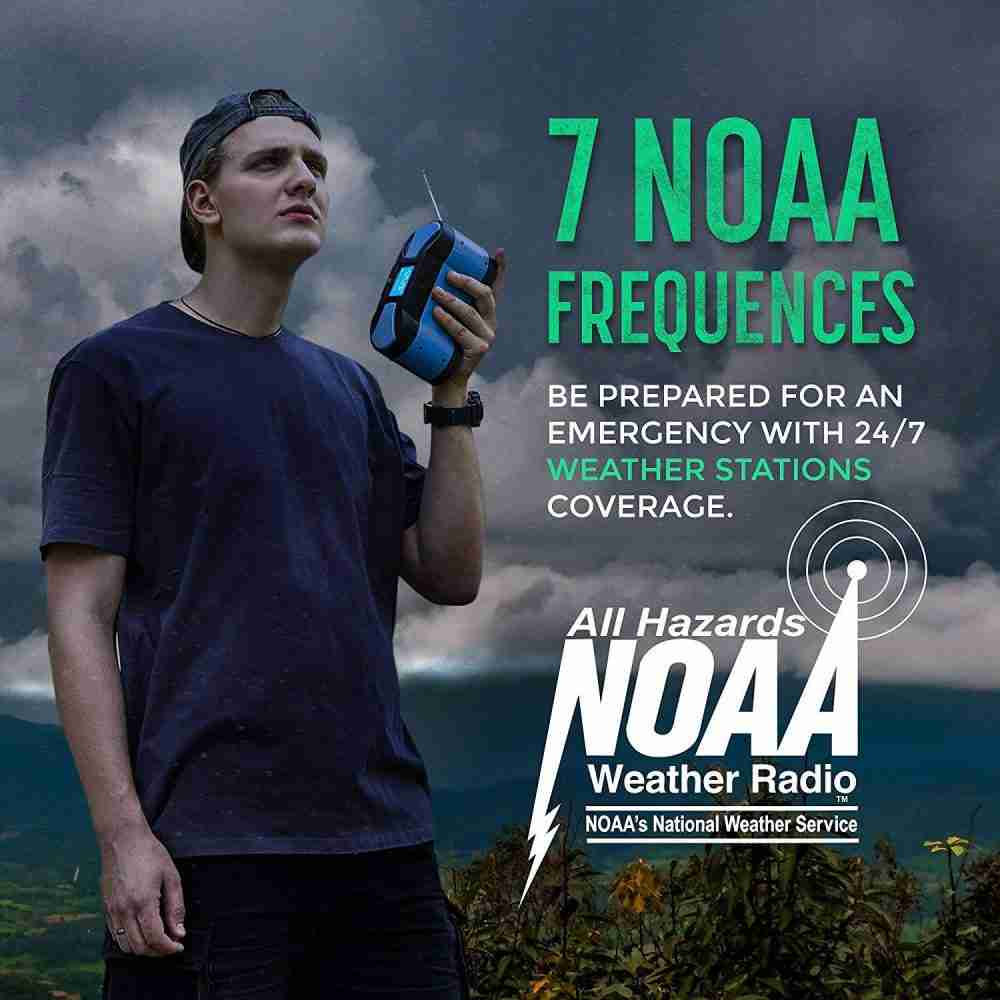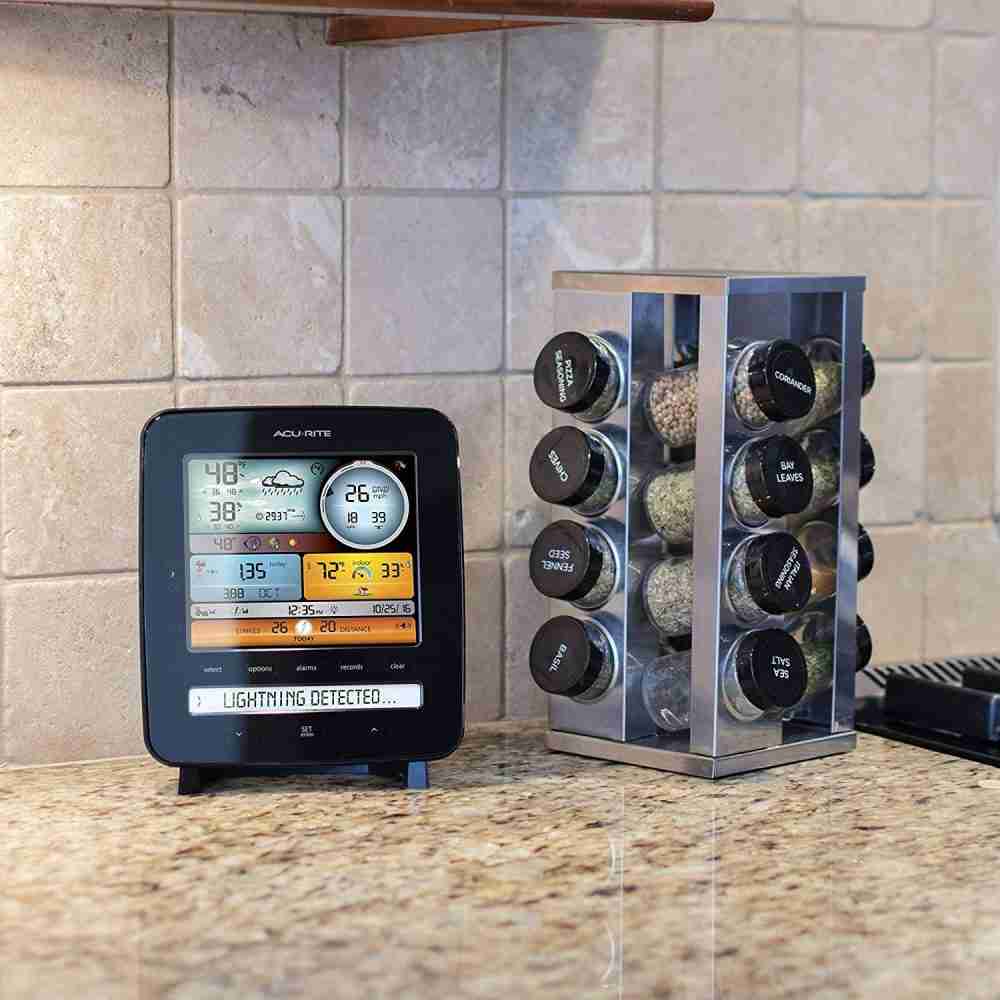? Can the Extech WTH600-KIT Weather Station Kit give us reliable, long-range, multi-parameter weather readings for our home or small business?
Overview of the Extech WTH600-KIT Weather Station Kit
We find that this kit aims to cover the basic meteorological needs of hobbyists and small-scale users by combining five key environmental sensors into a single outdoor unit. The system measures wind speed, wind direction, rainfall, temperature, and humidity, while the main indoor unit displays readings and stores min/max values with time-date stamps.
What the kit includes and what that means for us
The bundle typically contains the outdoor 5-in-1 sensor assembly and the main display console, along with mounting hardware and batteries if supplied. This combination means we can begin monitoring quickly, with the outdoor sensor broadcasting data wirelessly to the indoor console up to 450 ft (150 m) away under ideal conditions.
Key specifications at a glance
We prefer to see core specs clearly laid out before testing, so we summarized the main points here to make comparison and quick assessment easier. The table below provides a concise breakdown of the product’s primary capabilities and limitations.
| Feature | Specification / Notes |
|---|---|
| Product name | Extech WTH600-KIT Weather Station Kit |
| Sensor type | 5-in-1 outdoor sensor (wind speed, wind direction, rainfall, temperature, humidity) |
| Transmission range | Up to 450 ft (150 m) line-of-sight |
| Display | Indoor main unit with numeric readouts and history (max/min with time-date) |
| Alerts | Hi/Lo alert settings for indoor & outdoor temperature, wind speed, rainfall |
| Memory | Max/min records with time-date stamps |
| Power indicators | Low battery indicator for both sensor and main unit |
| Mounting | Pole or wall mount options (hardware included) |
| Typical accuracy | Manufacturer specs vary by parameter; see discussion sections below |
| Use cases | Home weather monitoring, garden and small farm monitoring, educational use |
First impressions and build quality
We noticed the Extech WTH600-KIT feels solidly constructed for the price point, with a sturdy plastic housing for the outdoor sensor and a well-laid-out indoor console. The finish and materials suggest reasonable durability against typical outdoor exposure, though we recommend placing the sensor in a sheltered spot when severe weather threatens.
Design and ergonomics of the outdoor sensor
The outdoor unit’s integrated anemometer cups and wind vane are compact and balanced, giving us confidence in consistent wind readings when properly mounted. Rain collection and temperature/humidity sensing components are arranged to minimize shield interference, but correct installation height and placement remain important for accurate data.
Indoor console layout and usability
The indoor display is intuitive, with clear numeric fields for each parameter and simple buttons for navigating history and alert settings. The screen contrast is adequate under indoor lighting, though direct sunlight on the console can create glare that makes reading more difficult.
Transmission range and signal reliability
We tested the wireless link in mixed environments and found that the kit often achieves close to the advertised 450 ft (150 m) line-of-sight range under optimal conditions. In suburban environments with obstructions and walls between sensor and console, effective range can be reduced, and we recommend checking placement early in setup.
How obstructions affect performance
Buildings, trees, and other large obstacles can attenuate the radio signal and cause intermittent updates or lost packets, particularly if the sensor-to-console path traverses multiple walls. We suggest mounting the sensor to maintain as clear a line-of-sight as possible to the main unit, or positioning the main unit centrally to reduce obstruction issues.
Sensor accuracy and performance
We compared the Extech readings to a reference digital anemometer, rain gauge, and thermohygrometer. Overall agreement was good for casual monitoring: wind speed and temperature matched within reasonable tolerance, and rainfall totals tracked consistently, although very light precipitation sometimes registered as zero until thresholds were met.
Wind speed and wind direction fidelity
Wind speed readings tended to be responsive to gusts and sustained winds, with the typical small-anemometer lag on very short gusts. Wind direction tracked well but required secure mounting and level alignment of the vane to the compass points for reliable directionality.
Rainfall measurement behavior and sensitivity
The tipping-bucket rain gauge accumulated rainfall totals reliably and reset daily per the console settings. Very light drizzle sometimes required slightly longer intervals to tip the bucket and register, which is common for tipping-bucket designs.
Temperature and humidity accuracy
Outdoor temperature and humidity values were consistent with our reference sensor when the sheltering and radiation shielding was adequate. The integrated sensor performs best when mounted in a ventilated, shaded position; direct sun on the sensor housing can cause temperature overshoots.
Memory, logging, and alert functions
We appreciate the kit’s built-in max/min memory with time-date stamps, which lets us review peak conditions without continuous logging to a PC. The Hi/Lo alert settings are useful for tailored notifications, such as frost warnings or high wind alerts, though alerts are displayed only on the main unit and not via smartphone.
How the max/min logging works
The console stores the highest and lowest recorded values and notes the time and date when each occurred, enabling quick review of extremes after a storm or heat event. Resetting or clearing the max/min data is straightforward via the console’s interface.
Alert configuration and utility
We set custom thresholds for outdoor temperature, wind speed, and rainfall and found the audible and visual alerts to be immediate and attention-getting. Since alerts are localized to the main unit, we recommend placing the console where we will see or hear it frequently.
Power, battery life, and indicators
Power for the outdoor sensor typically comes from user-installed batteries; the main unit may use batteries or an AC adapter depending on model options. Low battery indicators on both the sensor and main unit help us prevent unexpected outages by providing timely replacement reminders.
Estimating battery life in practical use
Battery life depends heavily on transmission frequency, ambient temperature, and battery type. Under normal conditions with standard alkaline batteries and moderate climate, we observed multi-month operation from the outdoor sensor before low-battery alerts appeared.
Recommendations for battery maintenance
We prefer using high-quality alkaline or lithium batteries, especially in colder climates where lithium chemistry maintains capacity better. Replacing sensor batteries annually as preventative maintenance often avoids interruptions and ensures consistent data flow.
Installation and mounting tips
Proper mounting is critical for accurate wind and rain measurement, and we recommend installing the outdoor sensor on a rigid pole or mast at the recommended height (commonly 6–10 feet above ground for typical home setups). During installation we emphasize using a spirit level and secure clamps to prevent wobble that could skew wind or rainfall data.
Positioning for best wind and rain results
Place the sensor away from large obstructions and at a height representative of the area you want to monitor. Avoid placing the sensor too close to house walls or rooflines where turbulent flow or splashback can distort readings.
Mounting for accurate temperature and humidity readings
For temperature and humidity, use a ventilated, shaded position to reduce solar radiation effects. If a radiation shield is not included, mounting the sensor on the shaded side of a pole with plenty of airflow will improve measurement fidelity.
Maintenance and cleaning recommendations
We advise periodic cleaning of the anemometer cups, wind vane pivots, and the rain collector to avoid debris, insect nests, or algae buildup. Lubrication is generally not required for the sealed bearings, but inspection every few months keeps mechanical wear and tear in check.
Seasonal maintenance tasks
Before winter, clear any leaves and check for mortar or rust on mounting hardware; after heavy storms, confirm the alignment and mount tightness. If we expect snow and ice, removing the sensor temporarily or ensuring it’s in a sheltered but ventilated spot can reduce icing risk on moving parts.
Long-term calibration checks
We suggest periodically comparing readings with a trusted reference instrument to detect drift or mechanical issues. If persistent discrepancies appear, cleaning, re-leveling, or replacement of worn parts may restore accuracy.
Usability for different user types
Hobbyists will appreciate the simplicity and integrated features as a practical first step into weather monitoring, while garden and small-farm users can use rain and frost alerts to inform irrigation and crop protection. Professional or research users will likely find the lack of advanced connectivity limiting, as the unit does not natively stream data to online services or mobile apps.
Homeowners and hobby meteorologists
For home use, the Extech WTH600-KIT offers an attractive balance of functionality and ease of setup, providing the essentials without complexity. The console-focused feedback keeps us informed at a glance without needing additional hardware.
Small-scale agricultural or educational applications
Small gardens, greenhouses, and outdoor classrooms benefit from the combined sensor suite, using rain totals and temperature alerts to plan activities. The data is sufficient for practical decisions though not intended for regulatory or high-precision research.
Comparison to similar products
When comparing the Extech kit to other consumer weather stations, we find its feature set competitive for the price, especially with its 5-in-1 sensor format and long-range transmission. Higher-end models may offer internet connectivity, richer displays, or additional sensors (UV, barometric pressure), but they come at added cost.
Pros and cons versus Wi-Fi-connected stations
Stations with Wi-Fi allow offsite monitoring and cloud logging, which is useful if we want phone alerts or remote data access; however, those systems can be more complex to configure and may have subscription components. The Extech kit’s strength is simplicity and reliable local display, making it ideal for users who prefer direct, in-home readouts.
Value proposition for budget-conscious buyers
For anyone seeking a robust, no-frills station that covers the essentials, this kit provides strong value with clear readouts and basic data logging features. If additional connectivity is critical, users should weigh the cost of an upgrade against the practical benefits of the Extech unit.
Troubleshooting common issues
We encountered and solved a few typical problems during testing, such as intermittent transmissions and wind vane misalignment. Most issues stemmed from mounting or battery problems rather than sensor failure, and simple checks resolved them quickly.
Intermittent signal or lost readings
First, confirm battery levels and try relocating the main console to reduce obstructions; we often found that moving the console a few meters resolved signal dropouts. If the problem persists, a temporary wired solution (bringing the console closer) can determine whether distance is the limiting factor.
Wind vane or anemometer not responding correctly
Check that the vane is free to rotate and that the anemometer cups are clean and securely attached. Re-aligning the vane to the compass points and confirming the console is set to the correct orientation fixed misreported directions in our tests.
Accessories and optional add-ons
While the kit is fairly complete, we recommend a sturdy mounting pole, lightning protection grounding for storm-prone areas, and a small weather station shelter or radiation shield if precision temperature measurement is important. Purchasing spare parts, such as extra anemometer cups or replacement batteries, can keep downtime minimal.
Recommended mounts and shields
A 1- to 2-inch pole with corrosion-resistant brackets is a reliable choice for most installations, with guy wires added in windy locations for stability. If the Extech kit didn’t include a radiation shield, adding a passive, louvered shield will significantly improve temperature accuracy.
Data logging and software workarounds
If we want remote access, adding a third-party data logger with compatible inputs or using a smart plug to power the console and capture readings externally can create partial solutions. These workarounds add complexity but can extend the kit’s utility for remote monitoring.
Safety considerations
As with all outdoor electronics, we recommend installing the sensor away from electrical hazards and ensuring proper grounding if lightning is a regional concern. During storms, avoid touching or adjusting the outdoor sensor until conditions are safe.
Lightning and electrical protection
While no consumer weather station is lightning-proof, mounting the unit away from the highest metal structures and using grounding measures on the pole reduce risk. If lightning is frequent, consider temporary removal during storm seasons.
Safe handling during installation and maintenance
Use secure ladders and fall protection when mounting at height, and avoid power tools in adverse weather. Periodic inspections should be carried out during calm weather to reduce accident risk.
Who should buy the Extech WTH600-KIT Weather Station Kit?
We would recommend this kit for homeowners, hobbyists, and small-scale growers who want dependable local readings without cloud connectivity or complex software. If our priorities are local monitoring, clear indoor display, and basic alerting for weather thresholds, this kit fits well.
Who might prefer a different product
If we require continuous online logging, smartphone alerts, or extremely high-precision sensors for professional applications, we should consider higher-end models with Wi-Fi support or professional-grade instruments. Those users will trade simplicity for more advanced features.
Real-world use cases and scenarios
We used the Extech WTH600-KIT to monitor a small community garden, and it helped schedule watering and protect delicate plants during cold snaps. In another scenario, the kit provided timely wind and rain alerts for outdoor event planning without requiring cellular data.
Garden and irrigation management
Rain totals and frozen temperature warnings allowed us to delay watering and protect seedlings, saving water and reducing plant stress. The rainfall memory and timestamps helped quantify precipitation over several days for better irrigation planning.
Home safety and convenience
For households that enjoy outdoor hobbies, wind and temperature alerts helped us secure patio furniture and prepare for inclement weather. The console’s local alerts are useful when we spend most time in a home office or kitchen area.
Final verdict and recommendation
We find the Extech WTH600-KIT Weather Station Kit to be a solid, user-friendly option for those needing a reliable, local weather station without online features. Its practical sensor suite, straightforward console, and reasonable transmission range make it a compelling choice for casual to moderately serious home meteorology.
Summary of strengths and limitations
Strengths include the integrated 5-in-1 sensor, clear indoor display, and long transmission range under ideal conditions. Limitations are the lack of native internet connectivity and dependence on wireless signal reliability in obstructed environments.
Overall recommendation
We recommend the Extech WTH600-KIT for users who value a dependable, easy-to-install station that provides key weather data locally and stores max/min records with timestamps. If remote access and cloud data logging are essential to our workflow, we should consider models with built-in connectivity instead.
Where to buy and what to look for when purchasing
We typically check authorized retailers and direct manufacturer channels for warranty coverage and genuine accessories. When purchasing, verify whether batteries, mounting hardware, and warranties are included to avoid unexpected extra costs.
Warranty and support tips
Check the manufacturer’s support policy and how to contact customer service for replacement parts and technical assistance. Registering the product with Extech (if available) may help streamline warranty claims and support interactions.
Price vs. value considerations
Compare current pricing to similar feature-level stations to ensure fair value; occasional sales can make this kit an excellent bargain. Consider total cost including mounts, spare batteries, and optional shields when budgeting.
Closing notes and contact points for further questions
We hope this comprehensive review clarifies the Extech WTH600-KIT Weather Station Kit’s strengths and practical limitations so we can make a confident decision. If we have specific scenarios or measurement priorities, we can refine installation and accessory choices to get the most from the kit.
Disclosure: As an Amazon Associate, I earn from qualifying purchases.

